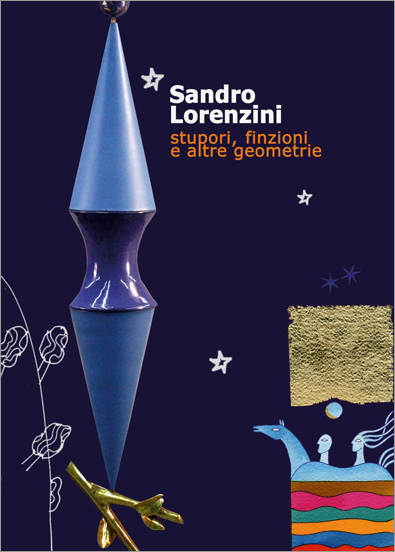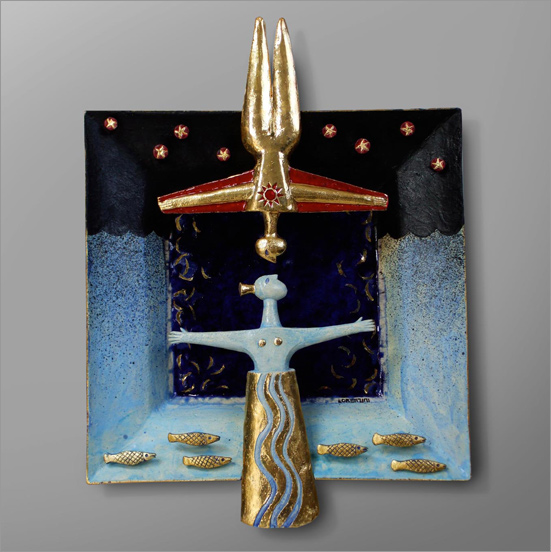Dec. 4, 2010 – Jan. 31, 2011
Savona – Italy
 The long theatrical activity as scenery designer and his interest in neofigurative art are the key contributors to Sandro Lorenzini’s ceramic works. Possibly these are also the reasons why he molds figurative forms, often archaic shapes that are suspended between dreams and nightmares.
The long theatrical activity as scenery designer and his interest in neofigurative art are the key contributors to Sandro Lorenzini’s ceramic works. Possibly these are also the reasons why he molds figurative forms, often archaic shapes that are suspended between dreams and nightmares.
In 1975, after many years spent creating theatre sceneries and listening to stories invented by other artists, Lorenzini started inventing his own stories, using sculptures instead of words. Clay had all the qualities he needed to give birth to the figures that were crowding into his mind.
In a lecture at the Foshan Ceramic Congress held in China in 2002, the artist explained why he was so much attracted by clay. He words were heartfelt and memorable: “ Clay is the material of creation, as many myths teach us: molding clay is God’s job. Using clay men can make everything and represent anything” (www.sandrolorenzini.it).
With patience and absolute commitment he learned the language of clay.
At the end of the Seventies, the dominant trend indulged the whims of the material and the instinct of the artist.  Lorenzini did something entirely different: his figures were polished, accurately designed, symmetric, severe and plain. And the material he chose met his special requirements: stoneware communicates strength even when molded to deliver simple, traditional or even geometric shapes.
Lorenzini did something entirely different: his figures were polished, accurately designed, symmetric, severe and plain. And the material he chose met his special requirements: stoneware communicates strength even when molded to deliver simple, traditional or even geometric shapes.
To him, to mold clay is to give a shape to a thought, to tell a story that has a strong relationship with the space it occupies, “a physical space, a fake space, a real space, a mental space”. The relationship between a sculpture and its space turns the objects into narrators.
Since 1986 Lorenzini has been displaying his works in public areas and buildings, that offered him the possibility to create “clay theatre actors”, playing roles directly inspired from the scenery surrounding them. He held his exhibitions in castles, ancient buildings, parks and gardens, museums and churches.
The setting becomes part of Lorenzini’s events. It offers the artist the theme to work on and the inspiration for the scenery: “the sculptures, their forms, the materials that will complement clay (steel, wood, sometimes bronze) take shape in my mind while the global vision of the scenery does.” So setting, scenery and art works combine together to form a coherent, unique whole.
Artist’s biography.
Sandro Lorenzini was born in Savona in 1948. After his graduation Academy of Fine Arts in Brera (Milan) he worked as a theatre scenery designer until 1975, when he decided to concentrate on ceramic art.
In the Eighties he was invited by Peter Voulkos to hold ceramic classes at the University of Berkeley, at the San Josè State University and at the California State University, while organizing his exhibitions in Italy, Europe, the USA, China and Japan.
From 1986 he has been experimenting with large ceramic sculptures and installations, often with strong historical features. His works are located in many public buildings and churches, In Italy and abroad. In 1990 he made two linear sculptures “Gesù e Giuseppe” (“Jesus and Joseph”) and “Chiara d’Assissi” (“Claire of Assissi”) for the Cathedral of San Josè in the United States.
He is considered one the most important Italian ceramic artists.
Stupori, finzioni e altre geometrie
Porticato del Crescent , 6
Antica Darsena – Savona
Ph: 0039 335 7502050
Email: sandro.lorenzini@gmail.com
